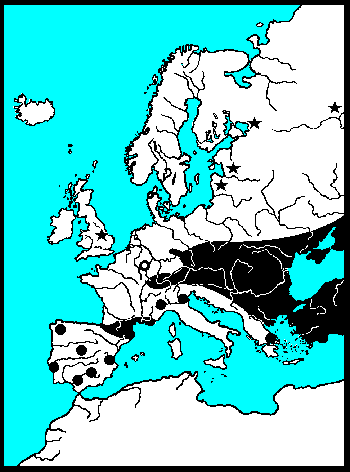
Legenda
Ooit
in
Luxemburg
waargenomen
(Mousset
1984)
en uit Frankrijk uit de Vogezen
(Bourgeois
1898; Horion
1951).
Stephens
(1839)
beschouwde
hem
als
indigeen
van Groot-Brittannië, en Buckland
& Buckland
(2008
en 2012) vermelden de soort als subfossiel uit het Glaciaal en
Laat-Glaciaal.
Verder
sporadisch
bekend
van
op
het
zuiden geëxponeerde hellingen
van
middelgebergten
in
het
zuiden
en
oosten.
In
Polen
zeer
zeldzaam
en
waarschijnlijk
verdwenen
(Borowiec
1992). Uit Duitsland
melden Fritzlar
&
Perner
(1994)
een
recente
vondst
uit Thüringen, maar aldaar op de Rode lijst als bedreigd (Fritzlar
2001), en op de nationale Rode
Lijst als sterk bedreigd (categorie 2) (Geiser, 1998). In 1974 in
Galicië, Noordwest Spanje (Baselga
& Novoa 2006). Ook
bekend uit de Baltische Staten (Letland Telnov
et al. 2003). Bukejs
(2009) schrijft over de
Noordoost-Europese
vermeldingen: "The
species is mentioned only in old bibliographical source (Precht 1818; Seidlitz
1872-1875, 1887-1891). Actual faunal data on this species in Latvia is absent.
Therefore it is deleted from the list of Latvian Coleoptera. According to the
catalogue of Silfverberg (2004), the species is mentioned for Latvia, Lithuania
and Karelia (as introduced species). In Belarus it is not known (Lopatin,
Nesterova 2005). The nearest known localities of this species are in S Lithuania
(V. Tamutis pers. comm.), S Poland and Ukraine (A. Warchalowski pers. comm.)." ARC
(in Centraal-Azië) EUS:
meu (sib) MED: (med)
tur
CEA CHI. Zie
ook Interactive
Agricultural Ecological Atlas of Russia and Neighboring Countries 2007.
Global
Biodiversity Information Facility (GBIF)

In 2010: 24 records/exemplaren uit
Duitsland (1), Polen (2), Frankrijk, Tsjechië (1), Spanje (2),
Oostenrijk (10), Kroatië (1), Hongarije (3), Roemenië (2) en Iran (1).
|
28 januari 2014 |